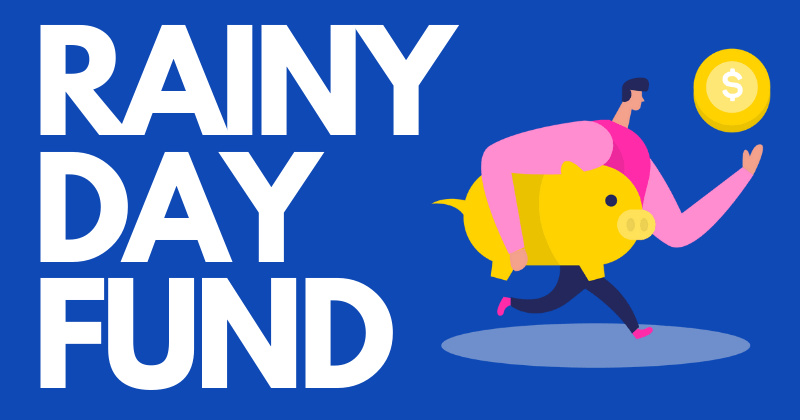Rainy Day Fund Vs Emergency Fund – Do You Need Both?

This article may contain affiliate links. If you make a purchase using my links, I’ll earn a small commission at no extra cost to you. I appreciate your support!
You’ve probably heard of the term ‘Emergency Fund’. It’s a fund created to financially help you during tough times i.e. emergencies.
Experts recommend maintaining an emergency fund of three to six months depending on your capacity to save.
Rainy Day Fund is a younger brother of an emergency fund, it does the same things as an emergency fund but in smaller quantities.
Rainy day funds are mainly to pay for small expenses. For example – Paying for the gym, paying for a spa treatment, or paying for your broken refrigerator.
Why Do You Need An Emergency Fund?
An emergency fund is intended to protect you when faced with a financial emergency. Emergencies are unexpected and under such circumstances, you need to have enough cash to utilize it during the emergency.
This may be the loss of your job, a close family member in the hospital, natural disasters or stock market crash, your close friend in need of cash, etc.
How Much Should I Save Each Month?

When you maintain an emergency fund, try to hit three to six months of all your expenses which include house payments, monthly groceries, minimum debt payments, bill payments, credit card payments, educational expenses, and transportation costs.
Many people maintain 3 months of expenses in their fund. I’d say start with a 3-month goal in mind but slowly move towards 6 months.
Sage Tip: If you live alone, it would be better if you save more than you normally would in your emergency fund account.
Why Do You Need A Rainy Day Fund?
A rainy day fund is intended to cover your small unexpected expenses. Paying for your child’s classes, car breakdown, or washing machine repairs.
A rainy day fund ensures you don’t go into debt every time some unexpected expenses pop up.
While $100 might not seem like a lot of cash, it certainly can break down your entire budget out of whack or even get you into debt. To cover such petty unexpected expenses, a rainy day fund is used.
How To Set Up Your Emergency Fund?
To set up your emergency fund, you first need to decide how much you can and are willing to keep in your emergency fund.
What’s a comfortable amount for you to keep aside that won’t be too difficult yet reasonable for you?
Some keep 3 months of expenses while some can easily maintain 6 months.
The goal is to keep aside some money, it can be 3 months or 6 months, and there needs to be something in that account.
Keep working on growing your account slowly once your minimum amount is hit.
Let’s say you decide to maintain 3 months of all living expenses. Your monthly expenses are $4000, so that means $4000 for 3 months is $12000.
If you set aside $1000 a month, then you’ll set your emergency fund in 12 months, if that’s tough, then $500 a month can get your emergency fund stacked up in 24 months.
Pick an amount that you can allocate to your emergency fund each month and work your way towards it. Once the fund is all setup, you’re done for now.
I suggest every 6 months you add one month’s expenses to it, just for additional safety.
How To Set Up Your Rainy-Day Fund?

The steps are the same, only the amount will vary. How much are you willing to contribute towards your rainy day account?
Once you choose that number (it should be less than the emergency fund), let’s move on to breaking it down into sizable amounts.
Let’s say you decide to maintain $2000 in your rainy-day account, now if you pay $50 a month, in 40 months you’ll be able to get to that amount.
Benefits Of Having An Emergency Fund and A Rainy Day Fund
The advantages of having a rainy day fund or an emergency fund are priceless. Here are a few benefits:
- You’ll reduce stress cause you know that during a financial crisis, you have a safety net.
- You’ll incorporate a money-saving mentality. This will benefit you in the future when your wants will increase in value and quantity. This also helps in reducing the effect of impulsive buying.
- When an emergency comes, you don’t need to depend on your friends and family, or your savings or take a loan. You have a fund to protect you at all times.
- Having a fund will increase your happiness make you more optimistic and will improve your overall productivity.
Where To Store Your Emergency Fund?
This fund is for your emergencies, that’s why it needs to be liquid and it also needs to be able to make some cash on its own.
The best place to store your cash is in a savings bank account.
A bank account that offers a high interest rate will be preferable. Your number 1 priority has to be for the funds to be available at all times.
Save your emergency fund savings in a high-interest highly liquid savings account that you can withdraw at any time.
When a Rainy Day Fund Isn’t Necessary
If you have a well-funded emergency fund or are working your way towards one, I don’t think you need a rainy day fund at all.
The basic purpose of a rainy day fund is to pay for small expenses but don’t we already do that today? When we have a small expense, we use the cash we already have to pay for it.
Let me explain – after spending on all your expenses, you have $1000 to save and you give $200 towards your emergency fund leaving you with $800.
$800 that you have saved acts as your savings and a source of funds which you can use when you need it, this also includes unexpected expenses.
Thus I see no point in making an additional account (rainy day account) to store a part of this cash for unexpected expenses.
The only reason why you should have a rainy day fund is if you spend all the time you have.
So if you saved $800, you’ll likely spend $700. In that case, please make an account and allocate some cash to it.
5 Steps To Build Your Rainy Day Fund

If you still feel you need a rainy day fund, that’s fine. It’s always good to have excess money saved for your future.
So to help you build your rainy-day fund, here are 5 simple steps.
1. Determine Your Ideal Rainy Day Fund Amount
Your rainy day fund is for basic expenses, so it doesn’t need to be too much. Maybe one month’s expense or half a month’s expense is fine.
But this depends on your lifestyle, I don’t usually face such expenses so I would keep a month’s worth of expenses in this fund.
Figure out your unexpected expenses and decide accordingly.
2. Open a Dedicated Savings Account
Don’t use the same savings account you use for your general cash. Also, don’t touch your emergency fund account. Open a new account that is solely focused on rainy-day problems.
3. Incorporate Rainy Day Fund into Your Budget
If you aren’t making a budget, it’s time to sit down and fill up the details. Add another column for rainy-day expenses. It will surely be useful for your future expenses.
4. Take a Gradual Approach
Just because your rainy day fund isn’t that big an amount, don’t try to fill it up at once. Take it easy and slowly fill up your account.
If you go too fast you might just spend that money too fast thinking that you can fill it up later (again). For example, if you’ve decided to save 100, divide it into 5 portions.
5. Build A Saving Habit
Building a rainy day account is essential, but it’s more than building a savings account with money in it to secure your future.
It’s the process that’s more valuable. The process of saving money and building a money-saving habit will not only help you to grow financially, but it will also teach you a lot.
Once you learn to save, you won’t spend on unnecessary things anymore.
If you’re an avid reader of this blog, you know how important an emergency fund is in your life.
Research shows that over 50% of Indian and American households don’t have an emergency fund!
That’s a huge number of people who are risking their financial condition and in time this ratio will only get worse if something is not done right.
The reason for such inadequate savings among so many individuals is mainly due to debt and other irrelevant expenses.
The truth is that most households today cannot handle an unexpected expense simply because they don’t think when they spend, as shocking as this sounds, it’s true.
If you’re in this situation right now, I highly suggest you read the following articles right away.
Have you enjoyed this post? If so, you might want to subscribe to my newsletter. It usually contains life lessons and money-related topics, some interesting observations, links to articles or books I’ve read, and tips to be a better person. If you’re interested in these things then subscribing will be simply wonderful 🙂 PS: Subscribe and Get your Freebie below!
Also, I’m a YouTuber now! If you’re interested in Pinterest Marketing, Blogging, or business-related things, Subscribe to my Channel and I’ll see you in the comments!